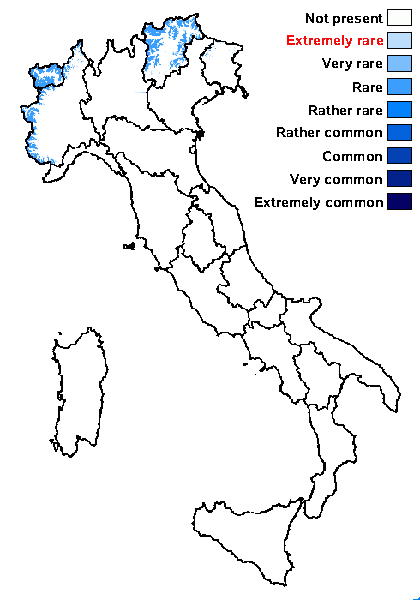Lecanora formosa (Bagl. & Carestia) Knoph & Leuckert
Herzogia, 14: 20, 2000. Basionym: Lecidea formosa Bagl. & Carestia - Comm. Soc. Critt. Ital., 2, 1: 82, 1864.
Synonyms: Lecidea alboradicata B. de Lesd.; Lecidea bullata auct. non (Körb.) Th. Fr. nec Meyen & Flot.; Lecidea contorta Bagl. & Carestia; Lecidea lacticolor Arnold; Lecidea mesotropiza Nyl.; Lecidea nansenii Lynge; Lecidea subdita Nyl.; Lecidella bullata auct. non Körb.
Distribution: N - Frl (Tretiach & Hafellner 2000), TAA (Hertel & Schuhwerk 2010, Nascimbene & al. 2022), Piem (Knoph & Leuckert 2000, Isocrono & al. 2003), VA (Piervittori & Isocrono 1999, Knoph & Leuckert 2000, Piervittori & al. 2004, Hertel & Schuhwerk 2010).
Description: Thallus crustose, episubstratic, white to grey-white, consisting of convex, often bullate-substipitate, up to 1.5 mm wide areoles-granules with an eroded surface. Apothecia cryptolecanorine to lecideine, to 1.5(-3) mm across, almost immersed in the thallus to subsessile, round to irregular in outline, with a flat to convex, black but usually grey-pruinose disc, a soon excluded, usually inapparent thalline margin, and a black, at first prominent, later excluded proper margin. Proper exciple dark brown in outer part, pale within, usually extending below the hypothecium, the inner part filled by crystals; epithecium blue-green to brownish green, with crystals dissolving in K; hymenium colourless, 40-70(-90) µm high, not inspersed with oil droplets, without crystals; lower part of hypothecium densely filled with crystals soluble in K. Asci 8-spored, clavate, very thin-walled, with a K/I+ blue, tall tholus penetrated by a faintly amyloid apical cushion, the wall K/I-, surrounded by a blue outer layer, Lecanora-type. Ascospores 1-celled, hyaline, ellipsoid, 7-12 x (4-)5-7(-8) µm. Photobiont chlorococcoid. Spot tests: thallus K+ yellow, C-, KC- or KC+ pale yellow, P+ deep yellow (medulla). Chemistry: atranorin, zeorin, and variable amounts of psoromic and 2’-0-demethylpsoromic acids.Note: on slightly rain-sheltered surfaces of siliceous rocks, especially crystalline schist, in humid and cold situations in the alpine and nival belts of the Alps, often starting the life-cycle on other crustose lichens.
Growth form: Crustose
Substrata: rocks
Photobiont: green algae other than Trentepohlia
Reproductive strategy: mainly sexual
In underhangs rarely wetted by rain
paras crustose lichens
Commonnes-rarity: (info)
Alpine belt: rare
Subalpine belt: extremely rare
Oromediterranean belt: absent
Montane belt: absent
Submediterranean belt: absent
Padanian area: absent
Humid submediterranean belt: absent
Humid mediterranean belt: absent
Dry mediterranean belt: absent

Predictive model
Herbarium samples
Growth form: Crustose
Substrata: rocks
Photobiont: green algae other than Trentepohlia
Reproductive strategy: mainly sexual
In underhangs rarely wetted by rain
paras crustose lichens
Commonnes-rarity: (info)
Alpine belt: rare
Subalpine belt: extremely rare
Oromediterranean belt: absent
Montane belt: absent
Submediterranean belt: absent
Padanian area: absent
Humid submediterranean belt: absent
Humid mediterranean belt: absent
Dry mediterranean belt: absent

Predictive model
| Herbarium samples |
 INDEX FUNGORUM
INDEX FUNGORUM
 GBIF
GBIF
 DOLICHENS
DOLICHENS

